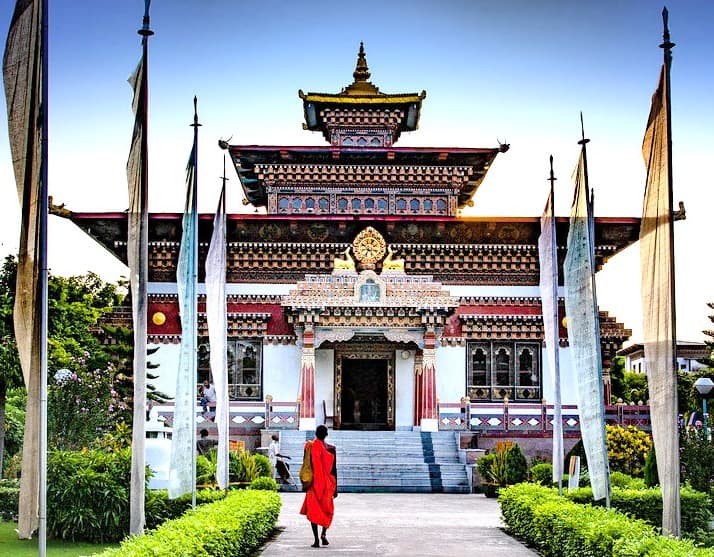Paro, a picturesque town in Bhutan, offers a unique blend of mystical heritage and stunning landscapes that attract travelers from all over the world. From the iconic Tiger's Nest Monastery perched on a cliff to the historic Paro Dzong, which showcases the finest Bhutanese architecture, Paro is a treasure trove of cultural and spiritual sites. The National Museum of Bhutan provides insights into the kingdom's rich history, while the ancient Kyichu Lhakhang stands as one of the top temples in Paro. For those who appreciate natural beauty, the Chele La Pass offers breathtaking panoramic views. Each site contributes to the vibrant tapestry of Paro Bhutan tourism, making it a must-visit destination for an authentic Bhutanese experience. Whether exploring historic sites in Paro or engaging in local customs and festivities, visitors are sure to find a deeply enriching cultural journey.
At Druk Holidays, we pride ourselves on being the premier choice for discovering the Must See Places in Paro. With our deep local expertise and commitment to providing exceptional experiences, we guide our guests through Paro's stunning landscapes and cultural treasures. From the awe-inspiring Tiger's Nest Monastery to the historically rich Paro Dzong, our tours are thoughtfully designed to ensure you capture the essence of Paro Bhutan tourism. We invite you to explore the historic sites in Paro, engage with the vibrant local culture, and marvel at the architectural wonders like the Kyichu Lhakhang and the Drukgyel Dzong ruins. With Druk Holidays, you’re not just visiting; you’re connecting deeply with the heart of Bhutan. Join us for an unforgettable journey to the best sights in Paro, where every detail is curated for your complete immersion and delight.
Tiger's Nest Monastery (Paro Taktsang)
Tiger's Nest Monastery (Paro Taktsang) stands as one of the most venerated and iconic landmarks in Bhutan. Perched precariously on the edge of a 3,120-meter cliff in Paro Valley, this monastery is a true testament to the spiritual and architectural prowess of the Bhutanese people. It is said that Guru Padmasambhava, the patron saint of Bhutan, flew to this location on the back of a tigress and meditated here in the 8th century, which led to the introduction of Buddhism to Bhutan.
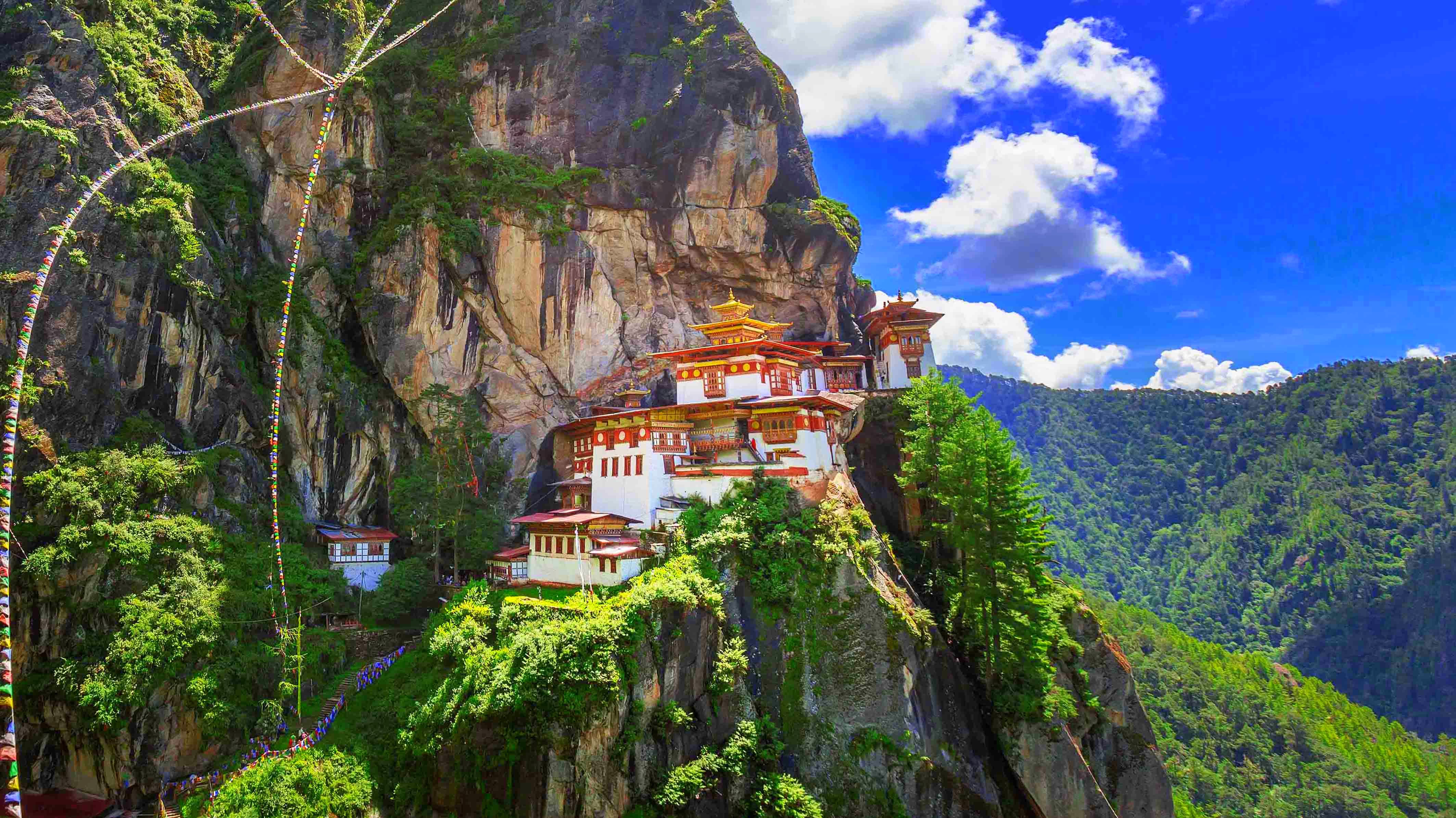
- Location: Tiger's Nest Monastery is dramatically situated on a cliff nearly 900 meters above the Paro Valley, offering awe-inspiring views and a feeling of serene isolation.
- Architecture: The monastery features a complex of four main temples and several other rooms. The buildings are interconnected by staircases with balconies that provide stunning views of the surrounding area.
- Spiritual Significance: It is one of the most holy sites in Bhutan, considered the birthplace of Buddhism in the country.
- Trek Experience: The trek to the monastery is both challenging and rewarding, with lush forests, prayer flags, and occasional glimpses of the valley below en route.
- Cultural Icon: Tiger's Nest is a symbol of Bhutan's commitment to preservation, spiritual heritage, and architectural wonder.
- Photography: A paradise for photographers, the monastery offers breathtaking backdrops of the cliff and the valley, ideal for capturing the essence of Bhutanese landscape and architecture.
- Wildlife: The journey to the monastery also offers chances to spot diverse wildlife, including several species of birds and possibly even mountain goats.
- Cafeteria: Halfway up the trail, there is a cafeteria where trekkers can rest and enjoy refreshments while soaking in the spectacular view of the monastery from a distance.
Visiting the Tiger's Nest Monastery is more than just a trek; it is a pilgrimage that offers profound insights into Bhutan's spiritual ethos and natural beauty. This journey not only challenges the body but also enriches the soul, making it a must-visit for anyone traveling to Bhutan. Whether you are drawn by the challenge of the hike, the spiritual aura, or the architectural grandeur, Paro Taktsang promises an unforgettable experience.
Rinpung Dzong (Paro Dzong)
Rinpung Dzong, commonly known as Paro Dzong, is one of the finest examples of Bhutanese architecture and an essential pillar of cultural heritage in Paro. Constructed in the 17th century, it serves both as a monastic and administrative center and stands majestically along the banks of the Paro Chhu (river). The dzong is a focal point of governance and religious life in the area, encapsulating the harmony between spiritual and secular duties that characterize Bhutanese society.
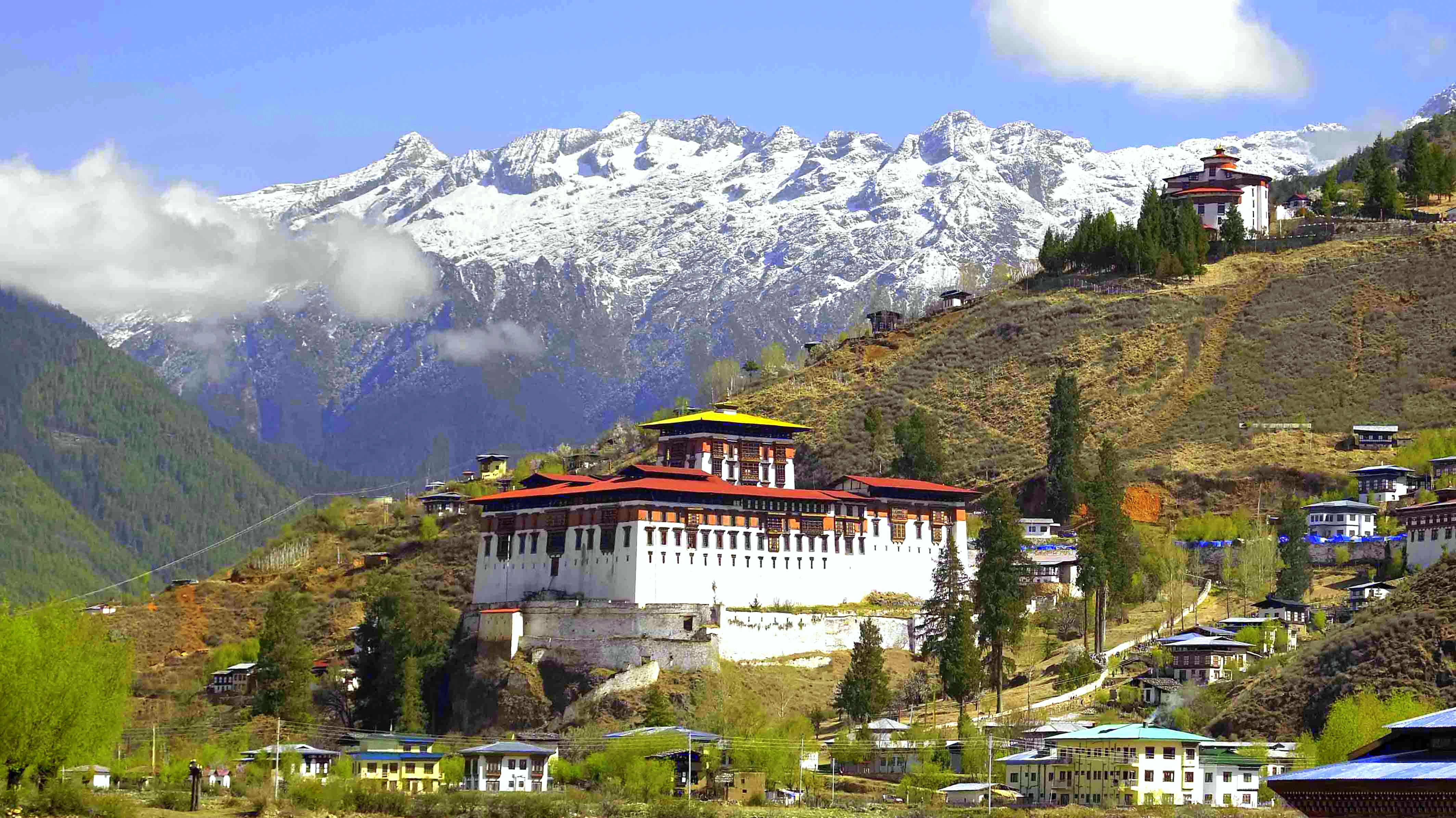
- Architectural Grandeur: Paro Dzong's massive buttressed walls that tower over the town are an impressive sight. The architecture is a beautiful example of the intricate and symbolic Bhutanese style, featuring wood-carved windows and balconies.
- Cultural Significance: It is the venue for the Paro Tshechu, one of Bhutan's most famous religious festivals, where masked dances and cultural displays take place every spring.
- Strategic Location: The dzong was strategically built to defend the Paro valley during times of war and now offers stunning views of the surrounding landscapes and the river below.
- Religious Importance: The dzong houses fifteen temples and chapels, including the sacred Sandalwood Stupa, which holds relics significant to Mahayana Buddhists.
- Administrative Role: As the administrative center of the Paro district, it houses the offices of the district court and other government functions, showcasing the dzong's role in both spiritual and civic realms.
- Artistic Displays: Inside, visitors can admire the exquisite Bhutanese art including intricate paintings, statues, and carvings that depict various Buddhist lore and deities.
- Tourist Accessibility: Unlike some private monastic sites, Rinpung Dzong is accessible to tourists, providing a profound insight into the culture and history of Bhutan.
- Environmental Integration: The dzong’s integration with its natural surroundings can be observed through its use of local materials and its positioning by the river, emphasizing the Bhutanese principle of environmental conservation.
Visiting Rinpung Dzong offers a deep dive into the spiritual, historical, and architectural heritage of Bhutan. It is a place where past and present coalesce, offering visitors a unique opportunity to experience Bhutanese culture in its most authentic form. Whether exploring during a quiet morning or participating in the vibrant festivities of the Tshechu, Paro Dzong stands as a testament to Bhutan's enduring cultural spirit and architectural prowess.
National Museum of Bhutan
The National Museum of Bhutan is a cultural gem located in Paro, offering a deep dive into the rich tapestry of Bhutanese history and art. Housed in the ancient Watchtower of the Paro Dzong, known as Ta Dzong, the museum was established in 1968 and has since become a repository of Bhutanese cultural and religious artifacts. It plays a crucial role in preserving and interpreting the nation's heritage for both locals and tourists alike.
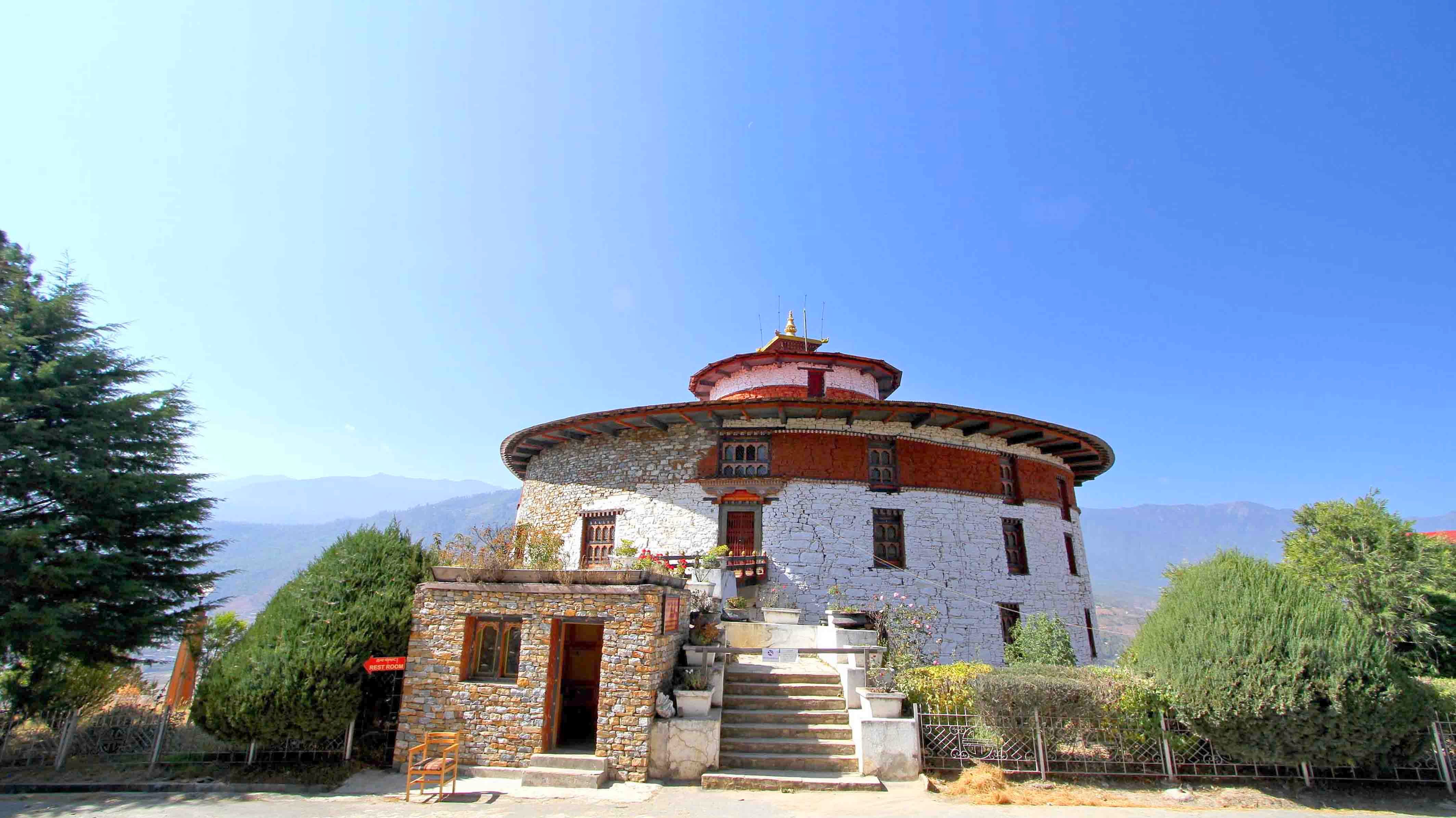
- Architectural Setting: The museum is set in a circular, conch shell-shaped building, offering panoramic views of the Paro valley. This unique structure was originally a watchtower built to defend the Rinpung Dzong below.
- Historical Artifacts: It houses a rich collection of over 3,000 Bhutanese artifacts including traditional costumes, religious paintings, armors, and more, spanning over 1,500 years of Bhutan’s cultural history.
- Thangka Collection: The museum boasts an impressive array of thangkas, which are religious Tibetan Buddhist paintings on cotton, or silk appliqué, representing the life of the Buddha, various influential lamas, and other deities and bodhisattvas.
- Bronze Statues and Masks: A significant collection of bronze statues and religious masks are displayed, which are used in Bhutanese rituals and dances.
- Philatelic Display: For those interested in philately, the museum offers an extensive stamp collection, which narrates the progress and changes in Bhutanese society.
- Photography Exhibit: There is also a fascinating exhibit of old photographs of Bhutan that offer a window into the past, showing the early days of the kingdom’s opening to the outside world.
- Natural History Exhibit: The museum also educates visitors about the country’s flora and fauna through its natural history exhibit, which includes a collection of preserved animals, birds, and insects.
- Folk Heritage: It also reflects the folk heritage of Bhutan through its array of traditional household objects, providing insight into the everyday lives of Bhutanese people through the ages.
The National Museum of Bhutan is more than just a museum; it's a vibrant centre of preservation and a showcase of Bhutan’s enduring traditions and cultural values. A visit here offers an educational and enlightening experience, making it a must-see for anyone interested in understanding the depth and diversity of Bhutanese cultural heritage. Whether you are a history buff, art lover, or simply curious about Bhutan, the National Museum of Bhutan provides a comprehensive and captivating overview of this Himalayan kingdom’s rich past and vibrant present.
Kyichu Lhakhang
Kyichu Lhakhang is one of the oldest and most revered temples in Bhutan, embodying the spiritual heritage and architectural tradition of the kingdom. Located in the Paro district, this temple dates back to the 7th century, making it a cornerstone of Bhutanese Buddhism and culture. It is said to be one of the 108 temples built overnight by the Tibetan King Songtsen Gampo to subdue a demoness laying across the Himalayas.
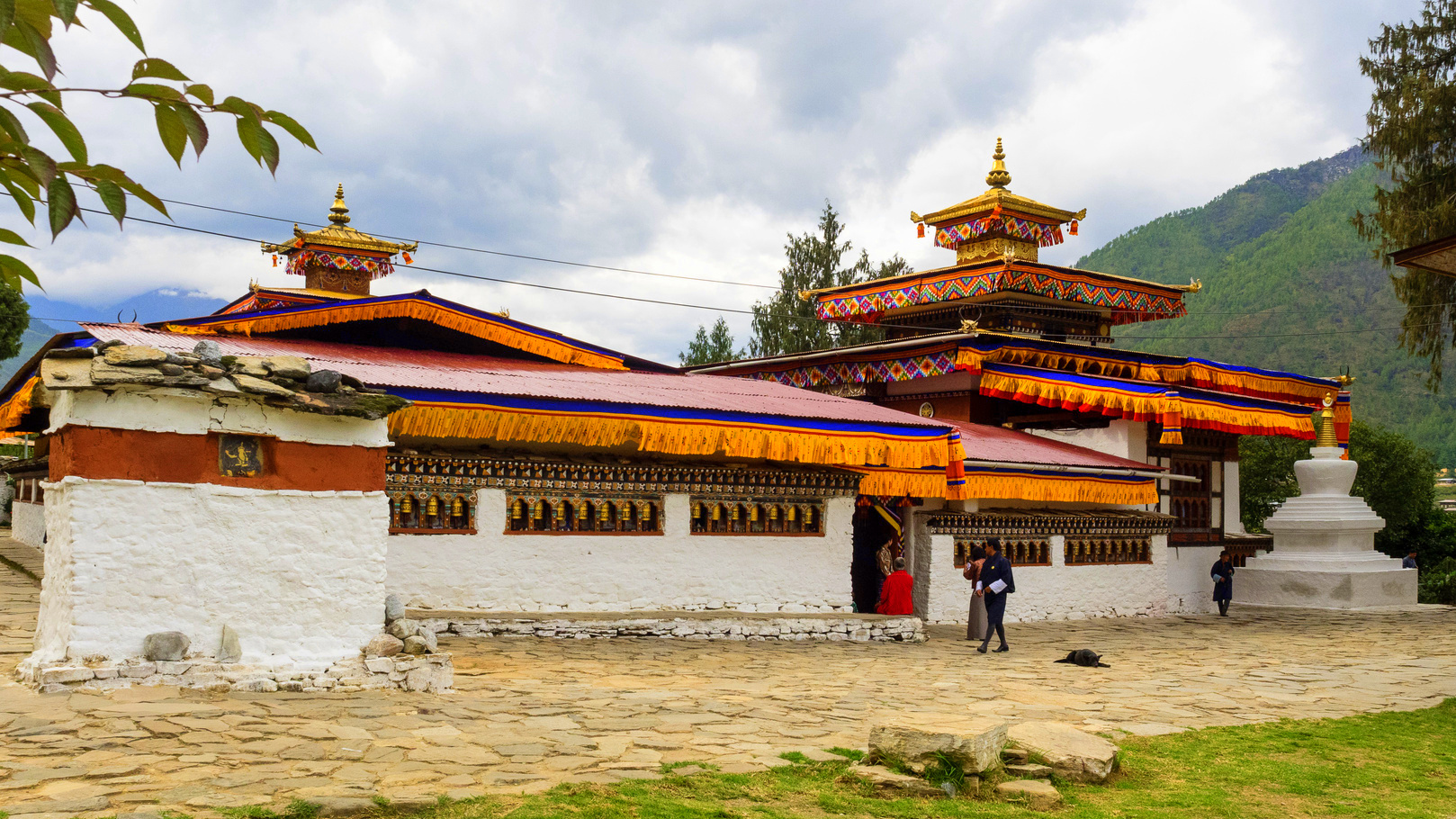
- Historical Significance: Kyichu Lhakhang is a pivotal site in the spread of Buddhism in Bhutan, being one of the first Buddhist temples established in the country.
- Architectural Beauty: The temple showcases traditional Bhutanese architecture with richly carved wooden windows and colorful Bhutanese textiles draping the walls, offering a visual feast for visitors.
- Spiritual Atmosphere: The temple is highly active with monks and pilgrims continually visiting, which adds to the serene and spiritual atmosphere pervasive throughout the site.
- Cultural Hub: As one of the top temples in Paro Bhutan, it serves not only as a religious site but also as a cultural hub where various religious ceremonies and festivals are held.
- Ancient Relics: Inside, the temple houses numerous ancient relics and statues, including a revered statue of Jowo Sakyamuni, believed to have been brought by the Nepalese wife of King Songtsen Gampo.
- Orange Tree: A notable feature within the temple’s courtyard is an orange tree that famously bears fruit all year round, considered miraculous by devotees and visitors.
- Expansion by the Queen: The temple complex was expanded in the 20th century by the Queen Mother of Bhutan, adding new structures that blend seamlessly with the old, enhancing both its spiritual capacity and architectural grandeur.
- Accessibility: Kyichu Lhakhang is easily accessible to tourists and provides an insightful glimpse into the spiritual practices and daily rituals of Bhutanese Buddhism.
Visiting Kyichu Lhakhang provides not only a peaceful retreat but also a deep connection to the historical and spiritual lineage of Bhutan. Its ancient walls and spiritual ambiance offer a profound insight into the Bhutanese way of life, making it an essential visit for anyone exploring the historic sites in Paro. Whether you are drawn by spiritual quest or historical interest, Kyichu Lhakhang stands as a testament to the enduring faith and cultural richness of Bhutan.
Drukgyel Dzong Ruins
Drukgyel Dzong Ruins stand as a historic emblem of Bhutan’s victorious past, located in the scenic Paro Valley. Built in 1649 by Zhabdrung Ngawang Namgyal to commemorate Bhutan's victory over Tibetan invaders, the fortress was once a strategic defense point and a thriving monastery. Although largely destroyed by fire in 1951, the ruins offer a poignant glimpse into the architectural and military prowess of ancient Bhutan.
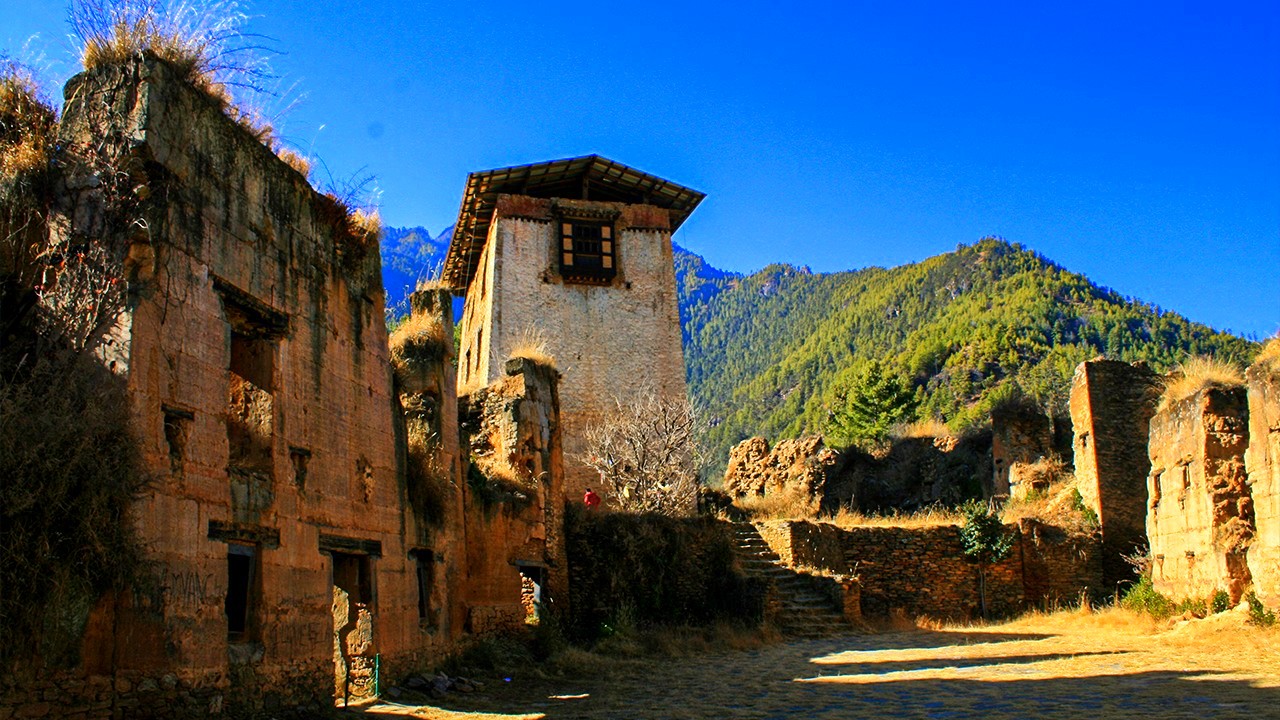
- Historical Background: Drukgyel Dzong was constructed to celebrate Bhutanese military success against Tibetan forces and has stood as a symbol of the nation's strength and resilience.
- Strategic Location: Positioned strategically with a commanding view of the valley, the dzong served both defensive purposes and as a gateway to the Paro Valley, controlling all passage to and from Tibet.
- Architectural Features: Even in its ruinous state, the dzong showcases the architectural ingenuity of the period, with remnants of massive walls, watchtowers, and intricate woodwork that hint at its former grandeur.
- Mount Jomolhari Views: The site offers breathtaking views of Mount Jomolhari, making it a favorite spot for photographers and nature lovers who come to capture the imposing backdrop against the fortress ruins.
- Cultural Significance: The dzong is associated with numerous legends and local folklore, adding a mystical allure to its historical and architectural appeal.
- Reconstruction Efforts: Recently, efforts have been made to stabilize and gradually restore parts of the dzong, aiming to preserve its historical significance and architectural integrity for future generations.
- Annual Festivities: The location is used annually for a local festival that re-enacts the historical themes associated with the dzong, drawing visitors and locals alike to celebrate its storied past.
- Tourist Attraction: Despite its state, Drukgyel Dzong remains a popular tourist destination, offering a stark reminder of the fierce historical conflicts and the strategic importance of Bhutan’s fortresses.
The Drukgyel Dzong ruins are a testament to Bhutan’s rich history and its centuries-old struggle against invasion. Visiting these ruins provides a unique perspective on the ancient defensive architecture and offers a tangible connection to Bhutan's past victories and challenges. As part of any tour of the historic sites in Paro, Drukgyel Dzong offers an evocative and educational experience that resonates with both history buffs and casual visitors.
Chele La Pass
Chele La Pass stands as one of Bhutan’s highest road-accessible passes, offering an unparalleled vantage point over the majestic landscapes of the Paro and Haa valleys. At an elevation of 3,988 meters, it provides breathtaking views and a thrilling drive, making it a favorite among nature lovers and adventure seekers visiting Bhutan.
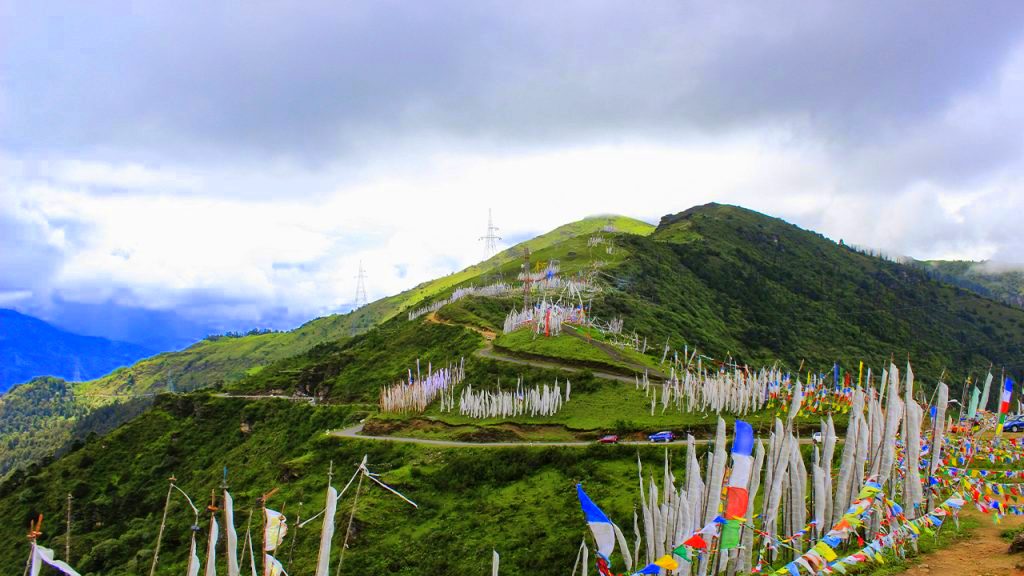
- Elevation and Scenery: At nearly 4,000 meters, Chele La Pass offers stunning panoramic views of the surrounding mountains, including the sacred Mount Jomolhari, making it a prime spot for photographers and nature enthusiasts.
- Access to Nature: The area around the pass is known for its dense spruce and larch forests, which give way to rhododendron bushes, providing a vibrant display of flora during the blooming season.
- Adventure Gateway: The pass serves as a starting point for several treks into the Haa Valley, appealing to trekkers looking to explore more secluded and untouched parts of Bhutan.
- Spiritual Sites: Nearby are several important religious sites, including temples and chortens, which reflect the deep spiritual heritage of the region.
- Flora and Fauna: The area is a habitat for diverse wildlife, including rare species such as the Himalayan monal pheasant, making it a spot of interest for wildlife watchers.
- Cycling and Motorbiking: Chele La is also popular among cyclists and motorbike enthusiasts who challenge themselves with the steep and winding roads that lead to the pass, offering an exhilarating experience.
- Picnicking Spot: With its crisp mountain air and scenic vistas, Chele La Pass is a perfect location for a picnic, providing a serene environment away from the bustle of tourist spots.
- Cultural Insight: Local herders often pass through or near Chele La with their livestock, providing visitors with a glimpse into the traditional lifestyles that continue to flourish in Bhutan’s remote landscapes.
Chele La Pass is more than just a high mountain pass; it is a celebration of Bhutan’s natural beauty and a testament to the adventurous spirit that the landscape invokes in its visitors. Whether you’re trekking, biking, or simply soaking in the vistas, Chele La offers a refreshing and invigorating experience that highlights the breathtaking beauty of Bhutan’s high-altitude landscapes. As part of any visit to Paro, a trip to Chele La Pass is sure to be a highlight, offering memories that last a lifetime.
Archery Grounds
Archery Grounds in Paro hold a special place in the cultural and social life of Bhutan. Archery is not only Bhutan’s national sport but also a profound way for locals to demonstrate their skill, celebrate their traditions, and engage in friendly competition. The grounds are vibrant venues where archers gather to compete using traditional bamboo bows and modern compound bows, making these events a colorful and integral part of Bhutanese festivals and daily life.
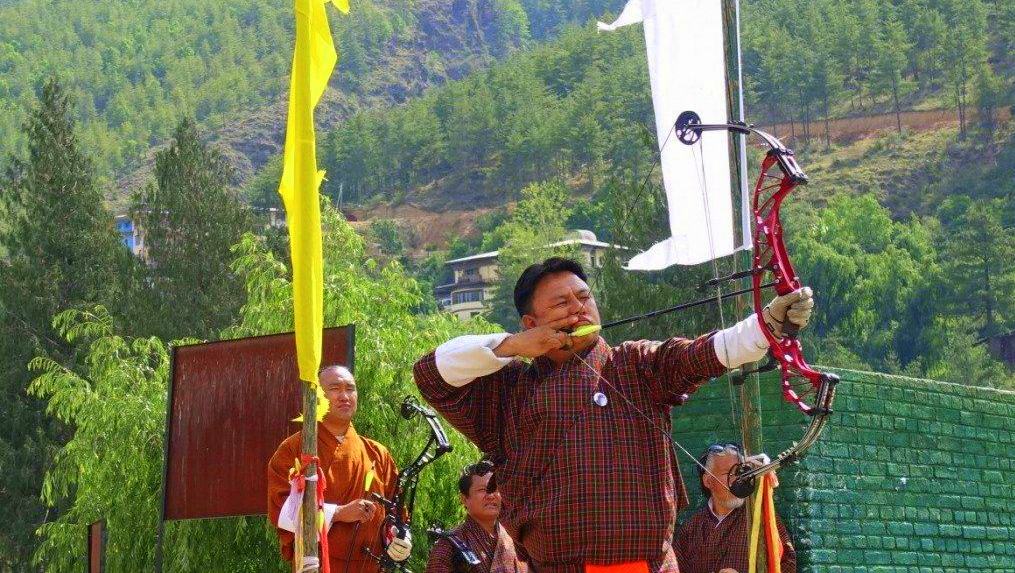
- National Sport: Archery is the national sport of Bhutan and a source of immense national pride, with competitions held throughout the country, especially in Paro.
- Cultural Significance: The sport is steeped in history and tradition, often accompanied by music, dancing, and festivities that reflect the rich cultural heritage of Bhutan.
- Festive Atmosphere: Matches are lively and festive, with teams dressed in traditional attire, making them a popular attraction for both locals and tourists.
- Skill and Precision: Archery competitions in Bhutan are not just about sport but also display the skill, precision, and concentration that archers bring to the grounds, showcasing an esteemed cultural art.
- Community Engagement: The events are highly social, with spectators actively participating through cheers and chants, providing a communal sense of involvement and enjoyment.
- Traditional Equipment: While modern archery equipment is used, traditional bamboo bows are also popular, maintaining a link to the historical aspects of Bhutanese archery.
- Scenic Settings: Archery grounds in Paro are often set against the backdrop of lush greenery and mountainous landscapes, providing a picturesque setting for both participating in and watching the sport.
- Accessibility for Tourists: Visitors are welcome to watch and sometimes even try their hand at archery, offering a unique and interactive cultural experience.
Visiting the Archery Grounds in Paro offers an insightful glimpse into Bhutanese culture, where the sport transcends mere competition to become a celebration of heritage, skill, and community spirit. For anyone looking to understand the social fabric of Bhutan, a day at the archery grounds is both enlightening and entertaining, providing a deeper appreciation for this beloved national sport. Whether you are a sports enthusiast or a cultural explorer, the archery grounds in Paro are a must-visit to experience the vibrancy and camaraderie that define this traditional Bhutanese sport.
Best time to visit Paro
Visiting Paro, Bhutan offers different experiences throughout the year, each season bringing its unique charms and attractions. Choosing the best time to visit depends largely on what you want to see and do. Here’s a guide to help you decide:
- Spring (March to May): Spring is one of the most popular times to visit Paro due to the favorable weather and the blooming of flowers. The temperatures are mild, making it ideal for outdoor activities such as trekking and sightseeing. This season also coincides with the famous Paro Tshechu, one of Bhutan’s most celebrated festivals, where you can witness vibrant dances and cultural displays in the courtyard of the Paro Dzong.
- Autumn (September to November): Autumn is another excellent time to visit Paro. The weather is clear and cool, providing great conditions for trekking and exploring. The skies are generally clear, offering stunning views of the Himalayas. Autumn also hosts several festivals, including another Paro Tshechu session, making it a culturally rich time for visitors.
- Summer (June to August): Summer in Paro is marked by the monsoon season, which can bring heavy rains and occasionally hinder outdoor activities. However, the landscape turns lush and green, waterfalls are at their fullest, and the valleys look vibrant. For those who don't mind a bit of rain, it can be a beautiful time to experience the rich flora and quieter tourist sites.
- Winter (December to February): Winter in Paro can be quite cold, but it’s a great time for those who appreciate serene landscapes and the tranquility of fewer tourists. The winter months might offer occasional snowfall, which can add a magical touch to the already beautiful Bhutanese architecture and landscapes. It’s also an excellent time for bird watching and enjoying the hot springs in nearby areas.
The best time to visit Paro largely depends on your interests. For cultural experiences and optimal trekking conditions, spring and autumn are ideal due to the moderate weather and the occurrence of major festivals. Summer and winter offer unique experiences like lush landscapes and tranquil environments, respectively, which can appeal to those looking for a quieter visit or specific scenic beauty.
Essential Tips for visiting Paro
Visiting Paro, with its rich cultural landmarks and breathtaking natural scenery, is a captivating experience. To make the most of your journey to this remarkable Bhutanese town, here are some essential tips to consider when exploring the must-see places in Paro:
- Plan Around Festival Dates: Attending a festival, like the Paro Tshechu, can significantly enhance your experience with unique insights into Bhutanese culture and traditions. Check the festival dates in advance and plan your trip accordingly.
- Dress Appropriately: Respect the local customs by dressing modestly, especially when visiting religious sites like Tiger's Nest Monastery and Kyichu Lhakhang. Shoulders and knees should be covered, and hats removed when entering temples.
- Hire a Local Guide: For sites like Tiger's Nest Monastery and Drukgyel Dzong ruins, having a knowledgeable local guide can enrich your visit with historical context and folklore, enhancing your understanding and appreciation of the sites.
- Stay Hydrated and Acclimatize: Many of Paro’s attractions, like the Chele La Pass, are at high altitudes. It’s important to acclimatize to the altitude, take it slow, and stay hydrated to avoid altitude sickness.
- Respect the Environment: Keep Paro beautiful by not littering. Many of the sites, especially on treks like the one to the Tiger's Nest, are pristine and should be kept free of trash. Always carry back what you bring in.
- Photography Etiquette: Photography is not allowed inside the temples and some specific areas of the dzongs. Always ask for permission before taking photos of local people or monks to respect their privacy.
- Check Opening Hours and Entry Fees: Many of the attractions in Paro have specific opening hours and require entry fees. Check these details in advance to plan your day efficiently and avoid missing out due to closures.
- Prepare for the Weather: Weather in Paro can change rapidly. Dress in layers and carry a raincoat or umbrella, especially if you are visiting during the monsoon season or planning to be outdoors for long periods.
- Try Local Cuisine: When visiting places like the National Museum of Bhutan or wandering around Paro town, don't miss out on trying local Bhutanese cuisine like Ema Datshi (chili and cheese) and Red Rice.
- Book Accommodations in Advance: Especially during peak tourist seasons in spring and autumn, accommodations can fill up quickly due to the influx of visitors. Booking your stay well in advance ensures you have a place to rest after your explorations.
Following these tips will help you enjoy a seamless and respectful visit to the must-see places in Paro, enriching your travel experience in this picturesque and culturally rich region of Bhutan.
Paro, with its stunning landscapes and rich cultural heritage, offers a diverse array of attractions that showcase the best of Bhutan. From the iconic Tiger's Nest Monastery that hangs miraculously on a cliff to the tranquil Kyichu Lhakhang, one of Bhutan’s oldest temples, Paro encapsulates the spiritual and historical essence of the country. The Paro Dzong and Drukgyel Dzong ruins provide a glimpse into Bhutan's storied past, while the National Museum of Bhutan offers insights into the nation's cultural depth. For nature enthusiasts, Chele La Pass presents awe-inspiring views at one of the highest points accessible by road. Each site in Paro is steeped in history and spirituality, providing visitors with a deeply enriching experience that goes beyond mere sightseeing. Whether you are an adventurer, a history buff, or someone seeking spiritual solace, Paro’s must-see places promise a journey that will captivate your heart and enrich your soul, making every moment spent here memorable.
FAQs of the Must see places in Paro
Q: What is the best time to visit Paro?
A: The optimal times to visit Paro are during the spring (March to May) and autumn (September to November). These seasons offer mild weather, clear skies, and are ideal for outdoor activities and festivals like the Paro Tshechu.
Q: How do I get to Tiger's Nest Monastery?
A: Access to Tiger's Nest Monastery involves a 4 to 6-hour round-trip hike from the base point near Paro. The trail is well-maintained but can be steep. It's recommended to hire a guide for enhanced safety and to gain historical insights.
Q: Are there entry fees for the attractions in Paro?
A: Yes, attractions such as the Tiger's Nest Monastery, Paro Dzong, and the National Museum of Bhutan typically have entry fees ranging from 300 to 500 BTN for international visitors.
Q: What should I wear when visiting religious sites in Paro?
A: Modest attire is required at religious sites; shoulders and knees should be covered. Shoes and hats should be removed before entering temple premises.
Q: Can I take photographs inside the monasteries and museums?
A: Photography is prohibited inside most monasteries and museums. You can photograph the exteriors and the surrounding landscapes.
Q: Do I need a guide to explore Paro?
A: While it's not mandatory, having a local guide can significantly enhance your experience by providing cultural context, historical details, and logistical support.
Q: What are some local dishes I should try in Paro?
A: Sample traditional Bhutanese cuisine like Ema Datshi (chili and cheese), Red Rice, and Momos (dumplings) to experience the local flavors.
Q: What are some tips for acclimatizing to the altitude in Paro?
A: To adjust to the altitude, take it slow initially, stay hydrated, eat light meals, and avoid alcohol. If you plan to visit higher altitudes, allow time to acclimatize in Paro first.
Q: Is it safe to travel to Paro?
A: Paro is generally safe for tourists. However, it's advisable to practice common safety precautions such as safeguarding your belongings and respecting local customs.
Q: How long should I spend in Paro to see all the major attractions?
A: Ideally, spend 3 to 5 days in Paro to thoroughly enjoy its major sites and immerse in the local culture without feeling rushed.


